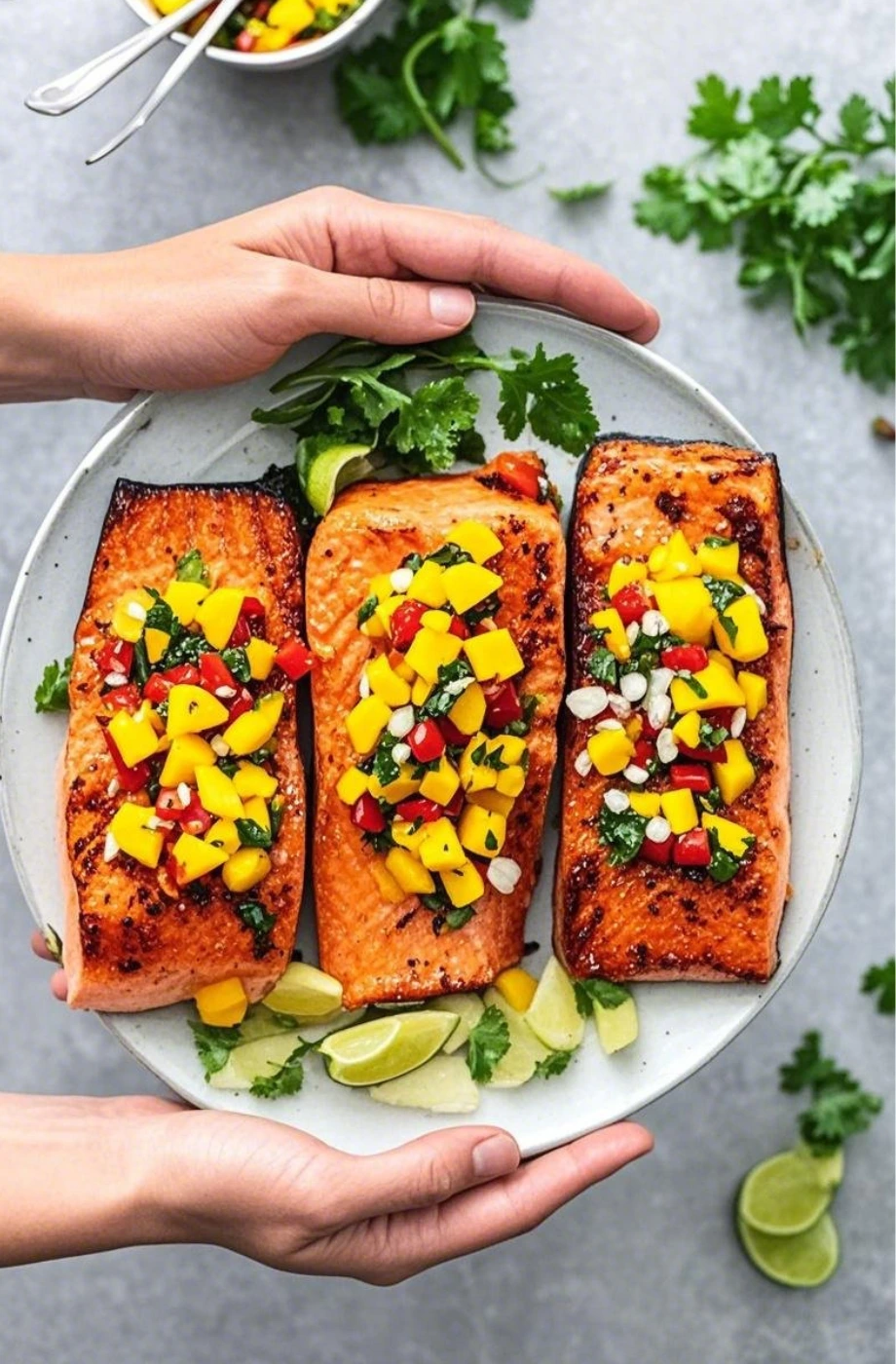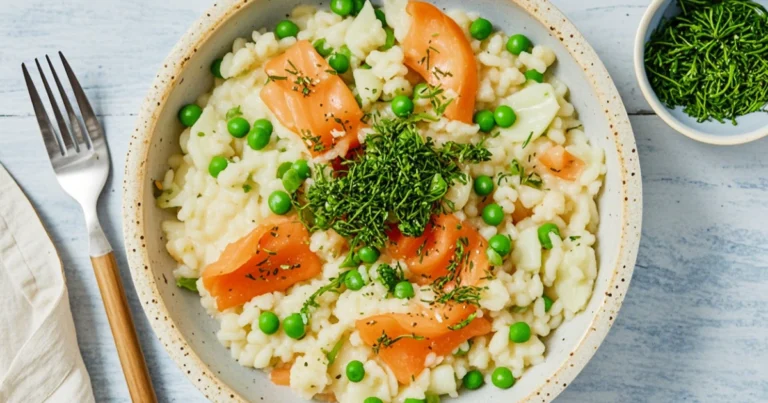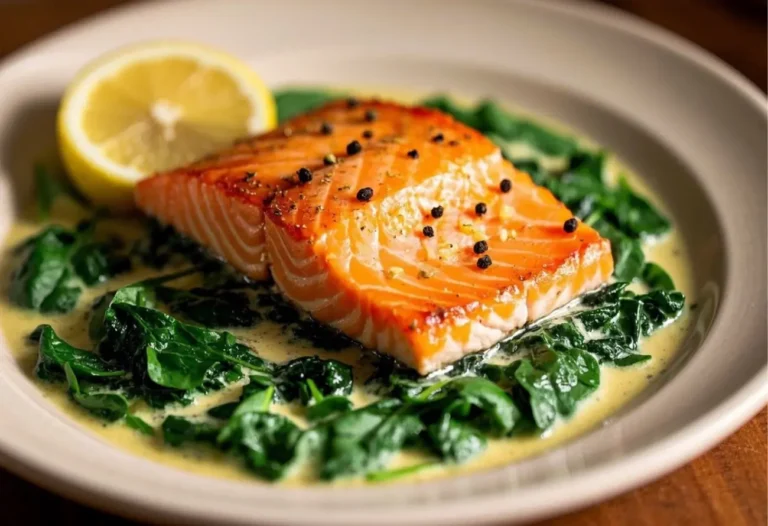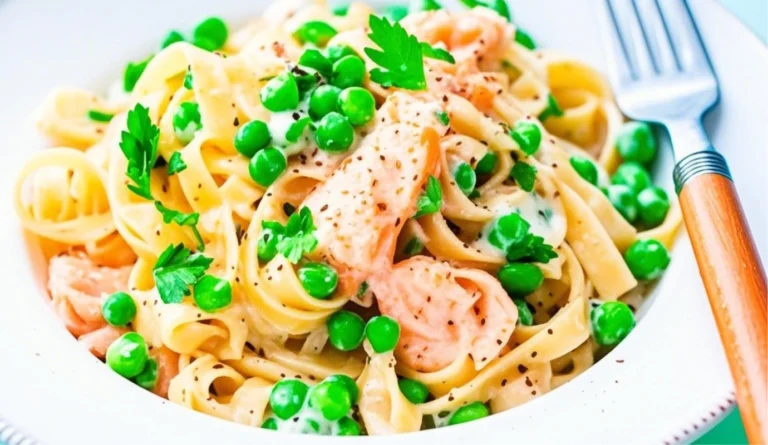Grilled Salmon with Mango Salsa: The Perfect Easy & Healthy Weeknight Dinner
Table of Contents
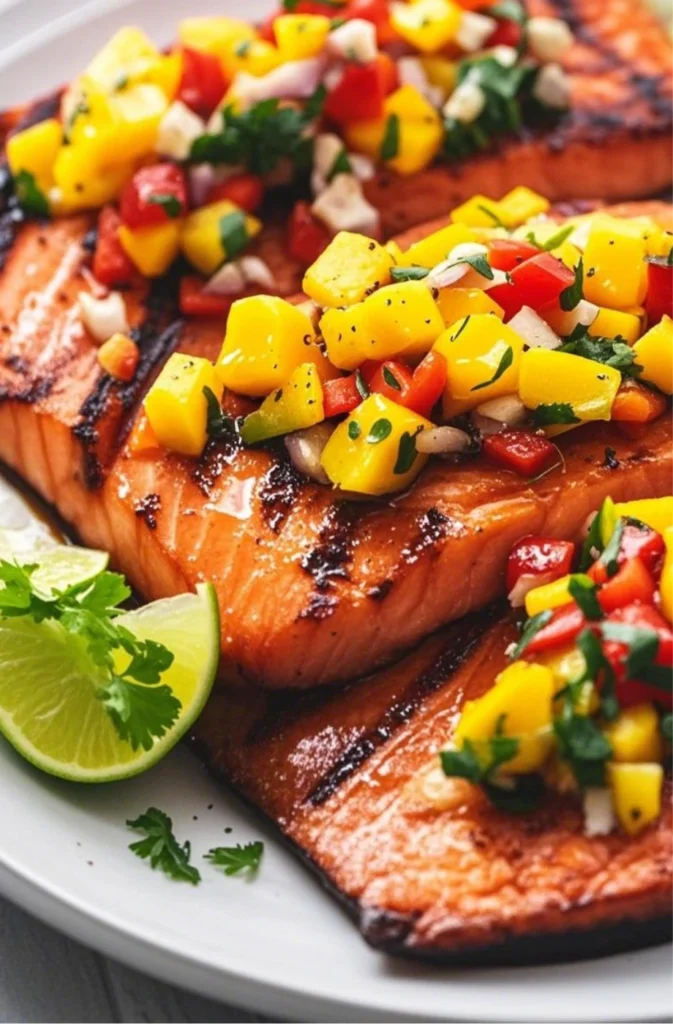
The gentle sizzle of salmon hitting a hot grill, the vibrant colors of freshly diced mango melding with crimson bell peppers and emerald cilantro—these sensory delights transport me back to that unforgettable summer evening along the Pacific coastline. The ocean breeze carried salt-tinged air as my host presented what looked like a sunset on a plate: perfectly grilled salmon crowned with a jewel-toned mango salsa. One bite, and I knew this dish would forever remind me of carefree coastal evenings.
Years later, this recipe has become my household’s saving grace on hectic weeknights when the temptation of takeout looms large. Perhaps you’ve experienced those moments—standing before an open refrigerator, exhausted from the day, wondering how to transform random ingredients into something nourishing yet delightful. This grilled salmon with mango salsa recipe might just become your culinary lifeboat too.
Why Salmon with Mango Salsa Should Be Your New Go-To Meal
Before diving into specifics, consider why this particular pairing deserves a permanent spot in your recipe collection:
- The marriage of omega-rich salmon with vitamin-packed mango creates a nutritional powerhouse that supports everything from heart health to immune function
- From refrigerator to table in under 30 minutes—quicker than most delivery options
- Impressive enough to serve unexpected guests, yet straightforward enough for Monday night dinner
- Creates a symphony of flavors: smoky charred salmon, sweet tropical mango, tangy lime, and the gentle heat of jalapeño
What truly distinguishes this dish is its remarkable versatility. Whether you’re hosting a sophisticated dinner gathering or simply craving something wholesome after a long workday, grilled salmon with mango salsa delivers both nutrition and satisfaction without demanding culinary expertise.
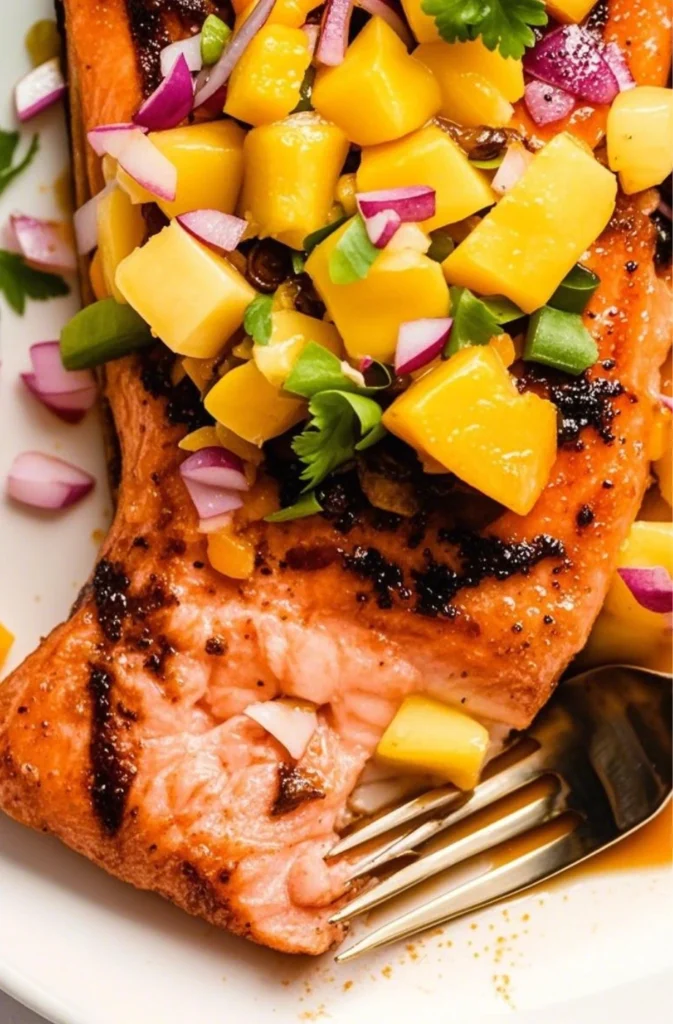
The Health Benefits of This Power-Packed Meal
Salmon: The Nutritional Superstar
Few proteins offer the impressive nutritional profile of salmon. This rose-hued fish regularly appears on “superfoods” lists for good reason:
- Omega-3 fatty acids: A 4-ounce serving provides approximately 2,000mg of omega-3s, which the American Heart Association links to reduced inflammation and lower heart disease risk. According to research published in the Journal of the American College of Cardiology, consuming fatty fish like salmon twice weekly can decrease cardiovascular disease risk by 36%.
- Protein powerhouse: Each serving delivers roughly 22-25 grams of complete protein, providing all nine essential amino acids your body cannot produce independently.
- Vitamin treasure chest: Salmon contains significant amounts of B vitamins (particularly B12, necessary for nerve function and DNA production) and vitamin D (which many Americans lack, especially during winter months).
- Selenium source: This often-overlooked mineral supports thyroid function and helps protect your cells from damage.
When selecting salmon, consider the source. Wild-caught Pacific varieties (like sockeye, coho, or king) typically contain fewer contaminants and more omega-3s than farm-raised alternatives. However, sustainably farmed salmon remains nutritionally valuable if wild options exceed your budget.
Mango Salsa: Not Just Delicious, But Nutritious
While mango salsa adds vibrant flavor and visual appeal, it contributes substantial nutritional benefits as well:
- Vitamin C abundance: One cup of mango provides nearly 67% of your daily vitamin C requirement, supporting immune function and collagen production.
- Digestive enzymes: Mangoes contain natural enzymes like amylases that break down complex carbohydrates, potentially aiding digestion.
- Anti-inflammatory properties: The combination of colorful bell peppers, onions, and fresh herbs delivers antioxidants that combat cellular inflammation.
- Weight management ally: This low-calorie topping adds tremendous flavor without the caloric density of creamy sauces or butter.
The beauty of mango salsa extends beyond nutrition—it transforms an ordinary protein into something extraordinary through contrasting temperatures, textures, and flavors.
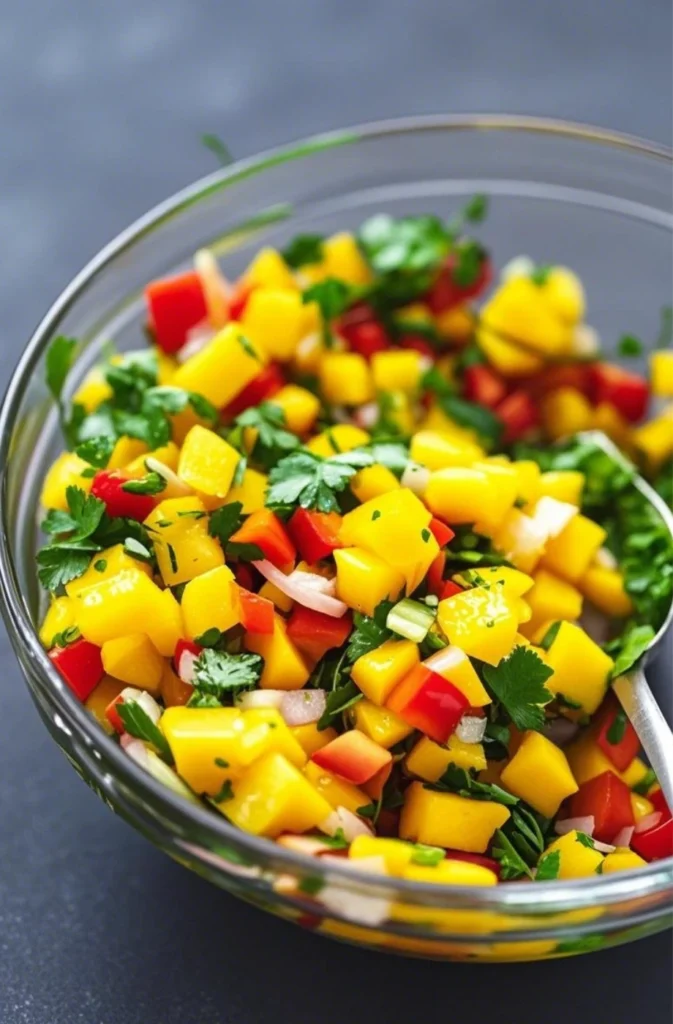
Selecting the Perfect Ingredients for Salmon with Mango Salsa
Choosing the Best Salmon
Your culinary journey begins at the seafood counter, where selecting quality salmon dramatically influences your final dish:
Wild vs. Farmed Considerations
While wild-caught salmon generally offers superior flavor and nutritional benefits, responsibly farmed salmon provides a more budget-friendly alternative. If selecting farmed varieties, look for certifications from organizations like the Aquaculture Stewardship Council (ASC) or Best Aquaculture Practices (BAP), which verify environmental responsibility.
At the Fish Counter
Quality salmon displays these characteristics:
- Moist appearance without excessive liquid in packaging
- Firm flesh that springs back when gently pressed
- Fresh, oceanic scent without fishiness
- Consistent color without brown spots or discoloration
Remember that previously frozen salmon works perfectly for this recipe—often, “fresh” supermarket salmon was frozen during transport anyway. If selecting frozen, examine packages for ice crystals or freezer burn, which indicate quality degradation.
Mango Selection & Ripening Tips
The foundation of exceptional mango salsa begins with perfectly ripened fruit:
Ripeness Indicators
Unlike many fruits that offer visual cues, mangoes reveal their ripeness primarily through touch and smell:
- Gentle pressure should yield slightly, similar to a ripe avocado
- Sweet fragrance near the stem end indicates peak ripeness
- Color varies by variety and doesn’t reliably indicate ripeness
Variety Matters
While any mango variety works for salsa, certain types offer advantages:
- Ataulfo (honey) mangoes provide smooth, fiber-free flesh ideal for salsa
- Kent mangoes offer aromatic sweetness with minimal stringiness
- Tommy Atkins (the most common supermarket variety) holds its shape well but contains more fibers
Ripening Assistance
To accelerate ripening, place unripe mangoes in a paper bag with a banana at room temperature. Check daily, as the ethylene gas released will speed the process considerably.
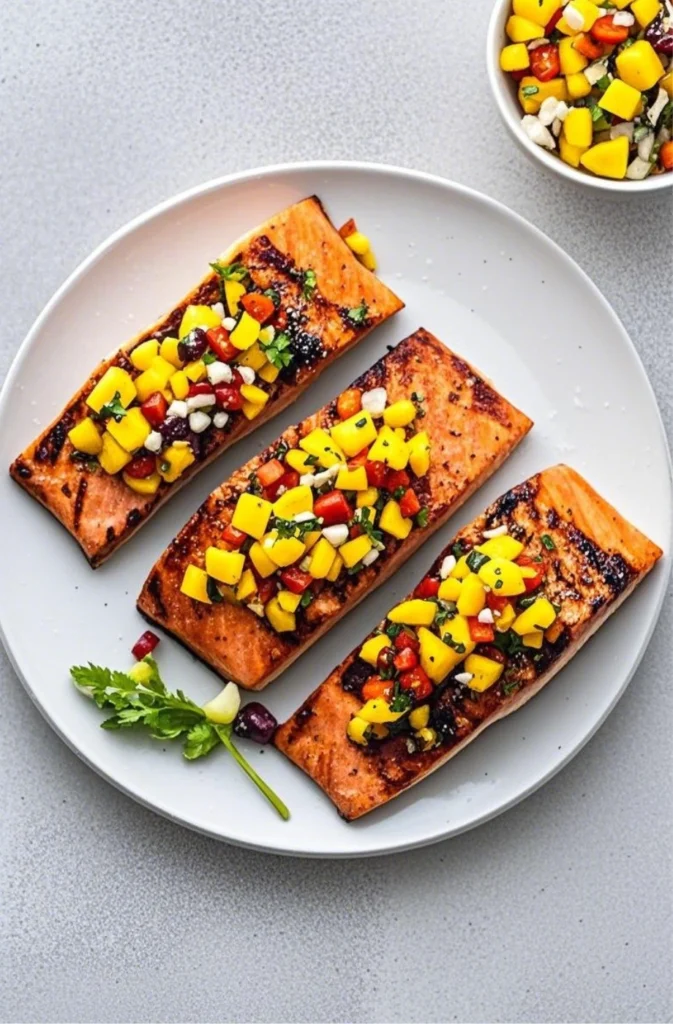
Supporting Cast: Other Ingredients for the Perfect Mango Salsa
While mangoes star in this salsa, supporting ingredients contribute crucial flavor dimensions:
Selecting Ripe Avocados
If including avocado, select fruits that yield to gentle pressure but aren’t soft. The small stem should remove easily, revealing green underneath (brown indicates overripeness).
Choosing the Right Onions
Red onions provide ideal sharpness and color contrast. To reduce pungency, soak diced onions in cold water for 10 minutes before draining thoroughly.
Fresh Herbs That Make a Difference
While cilantro traditionally complements mango salsa, those with the cilantro-aversion gene (affecting roughly 14% of the population) might substitute fresh mint or a combination of parsley and mint for brightening effects.
Essential Equipment for Grilling Perfect Salmon
Successful salmon grilling doesn’t require professional equipment, but certain tools elevate results:
Grill Options
Outdoor grills (gas or charcoal) impart characteristic smokiness, but indoor alternatives work beautifully:
- Cast-iron grill pans create authentic grill marks
- Electric grills offer smoke-free indoor options
- Broilers function as upside-down grills in standard ovens
Must-Have Tools
These implements prevent common grilling mishaps:
- Fish spatula (wider and thinner than standard spatulas)
- High-heat cooking oil spray or oil-soaked paper towel with tongs for grate preparation
- Instant-read thermometer for perfect doneness (145°F internal temperature)
Alternative Cooking Methods
When grilling proves impractical, consider these approaches:
- Broiling (4-6 inches from heat source)
- Baking (425°F for 12-15 minutes)
- Pan-searing followed by oven-finishing
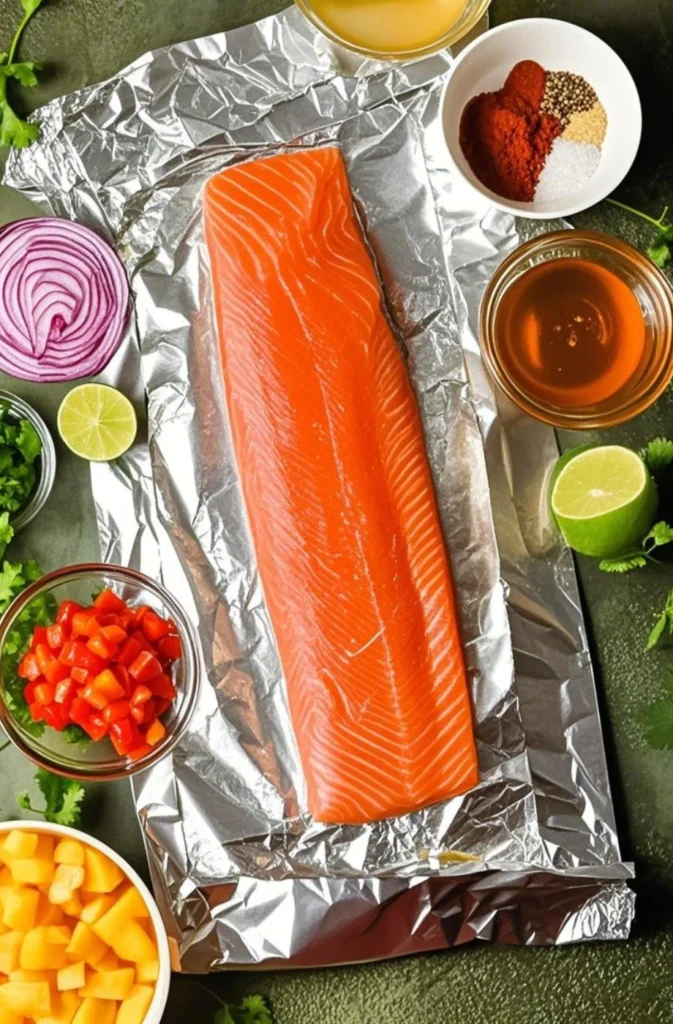
Grilled Salmon with Mango Salsa Recipe
Ingredients
| For the Salmon | For the Mango Salsa |
|---|---|
| 4 salmon fillets (6 oz each) | 2 ripe mangoes, diced (approximately 2 cups) |
| 2 tbsp extra virgin olive oil | 1 small red onion, finely chopped (about ½ cup) |
| 1 lime, juiced | 1 red bell pepper, diced (about ¾ cup) |
| 2 cloves garlic, minced | 1 jalapeño, seeded and minced |
| 1 tsp smoked paprika | ¼ cup fresh cilantro, chopped |
| ½ tsp ground cumin | 1 lime, juiced |
| ½ tsp kosher salt | 1 ripe avocado, diced (optional) |
| ¼ tsp freshly ground black pepper | ¼ tsp sea salt |
Marinade Instructions
- In a shallow glass dish, combine olive oil, lime juice, minced garlic, smoked paprika, cumin, salt, and pepper, whisking until emulsified.
- Pat salmon fillets dry with paper towels—this crucial step enables proper marinade absorption and prevents steaming instead of searing.
- Place salmon in the marinade, turning gently to coat all surfaces. While lengthy marination works for many proteins, salmon’s delicate flesh requires only 15-60 minutes. Beyond this window, the acidic lime juice begins breaking down the fish, potentially resulting in mushy texture.
Mango Salsa Preparation
- For uniform presentation and even flavor distribution, aim for consistent ¼-inch dice across all ingredients. This technique ensures balanced flavor in each bite without any single element overwhelming others.
- Combine ingredients in this sequence: mangoes first, followed by red onion, bell pepper, jalapeño, cilantro, and finally lime juice and salt. If including avocado, fold in gently last to prevent breaking.
- Allow salsa to rest 15-30 minutes before serving, which permits flavor melding while maintaining textural integrity. This resting period transforms disparate ingredients into a cohesive accompaniment.
Step-by-Step Grilling Instructions
- Preheat your grill to medium-high heat (approximately 400-425°F). Properly preheating prevents sticking and ensures appealing grill marks.
- Once hot, clean the grill grates thoroughly, then oil them using tongs holding an oil-soaked paper towel. This crucial step prevents the fish’s delicate skin from adhering to the cooking surface.
- Place salmon skin-side down on the preheated grill and resist the urge to move it prematurely. Cook for 4-5 minutes until the skin crisps and releases naturally from the grate.
- Using a fish spatula, carefully flip the salmon and cook an additional 3-4 minutes for medium doneness. For optimal food safety and texture, salmon should reach an internal temperature of 145°F while remaining moist.
- Transfer grilled fillets to a clean plate and allow them to rest 3-5 minutes before topping with salsa. This resting period allows juices to redistribute throughout the flesh, ensuring moist results.
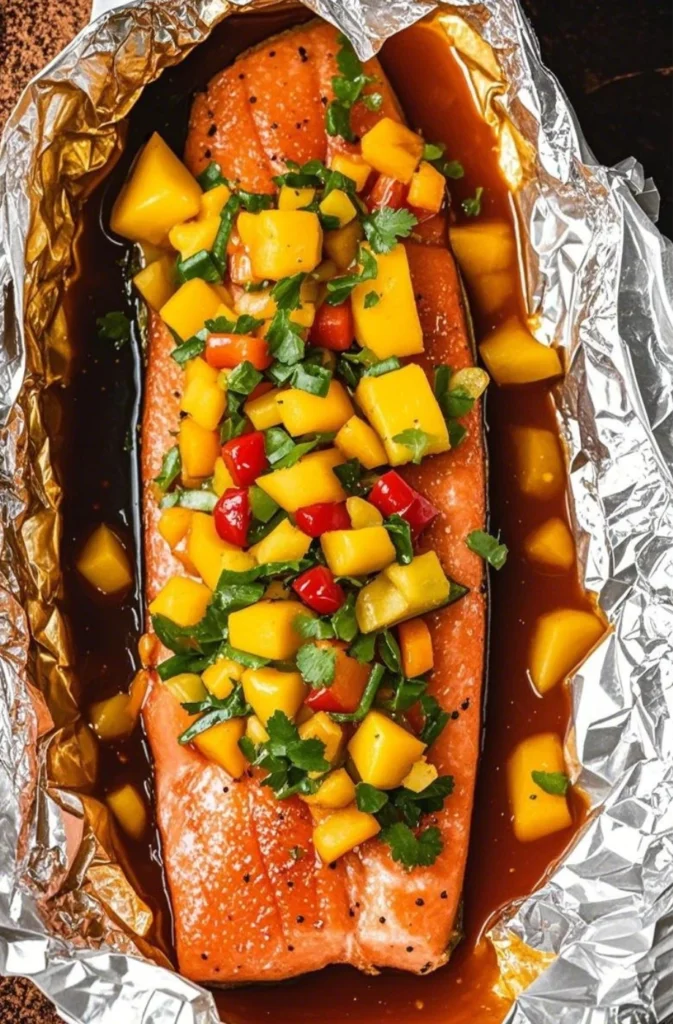
Plating and Serving Your Grilled Salmon with Mango Salsa
Presentation elevates this dish from merely delicious to truly memorable:
Visual Appeal Strategies
- Serve salmon atop a bed of black or forbidden rice for dramatic color contrast
- Mound salsa generously in the center of each fillet rather than spreading it
- Garnish with additional cilantro sprigs and lime wedges
- Consider a light drizzle of reduced balsamic or chili-infused honey around the plate’s perimeter
Complementary Side Dishes
The tropical notes in this dish pair beautifully with:
- Coconut rice or cilantro-lime rice
- Grilled asparagus or zucchini
- Avocado and grapefruit salad
- Black bean and corn salad
Beverage Pairings
For wine enthusiasts, consider these complementary options:
- Crisp Sauvignon Blanc cuts through salmon’s richness
- Unoaked Chardonnay harmonizes with mango’s sweetness
- Dry rosé balances both components
Non-alcoholic alternatives include sparkling water with muddled cucumber and lime or passion fruit iced tea.
Make-Ahead Strategies for Entertaining
When serving guests, prepare components strategically:
- Marinate salmon up to one hour before cooking
- Prepare salsa ingredients (except avocado) up to four hours ahead, storing covered in the refrigerator
- Add lime juice, salt, and optional avocado just before serving
Customizing Your Salmon with Mango Salsa
This versatile recipe welcomes personalization based on preference, dietary needs, or seasonal availability:
Heat Level Adjustments
Modify spiciness through these variations:
- For milder salsa, remove jalapeño seeds and membranes or substitute milder poblano pepper
- For heightened heat, incorporate serrano or habanero peppers, or add a pinch of cayenne to the salmon marinade
- Red pepper flakes offer controllable heat when added as a finishing touch
Dietary Modifications
This naturally dairy-free, gluten-free recipe accommodates additional restrictions:
- Paleo/Whole30: Ensure all ingredients contain no added sugars
- Low-carb/keto: Reduce mango quantity and increase avocado for similar textural experience
- AIP-friendly: Eliminate nightshades (bell pepper, jalapeño, paprika) and seed-based spices
Seasonal Variations
When mangoes aren’t at peak quality, consider these alternatives:
- Summer: Substitute peach, nectarine, or plum
- Fall: Incorporate diced apple or pear with pomegranate seeds
- Winter: Create citrus salsa with orange segments, grapefruit, and avocado
- Spring: Feature strawberries with jicama and mint
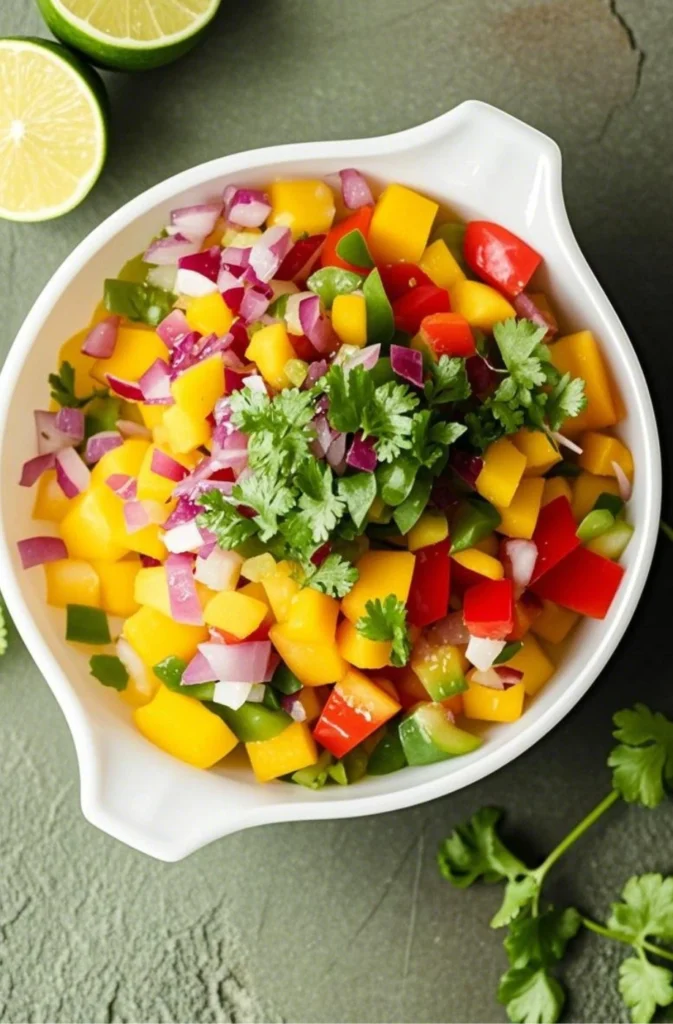
Meal Prep Tips for Salmon with Mango Salsa
Transform this dish into a meal planning cornerstone:
Storage Best Practices
For optimal quality:
- Store cooked salmon and salsa separately in airtight containers
- Consume salmon within 2 days for best flavor and texture
- Salsa remains vibrant for approximately 24 hours before texture degradation begins
Reheating Recommendations
Salmon requires gentle reheating to prevent dryness:
- Allow refrigerated salmon to reach room temperature (about 15 minutes)
- Reheat in a 275°F oven for 15 minutes until just warmed through
- Add fresh salsa after reheating, rather than reheating the salsa itself
Creative Leftover Transformations
Repurpose components into new meals:
- Flake chilled salmon into breakfast frittatas
- Create salmon-mango tacos with corn tortillas and cabbage slaw
- Combine with quinoa, greens, and citrus vinaigrette for grain bowls
- Transform into salmon salad for sandwiches by gently mixing with light mayonnaise and celery
Conclusion
There’s something magical about the contrasts in grilled salmon with mango salsa—the warm, smoky salmon against cool, vibrant salsa; the rich fattiness of fish complemented by tropical fruit acidity; the nutrient density paired with preparation simplicity. This dish embodies what home cooking should be: straightforward yet sophisticated, nourishing yet indulgent.
Whether you’re seeking weeknight efficiency, nutritional excellence, or crowd-pleasing flavor, this recipe delivers remarkable versatility. The next time you stand before your refrigerator contemplating dinner options, remember that extraordinary meals often require just a few quality ingredients and simple techniques.
Have you transformed your own dinner routine with this grilled salmon and mango salsa? Share your adaptations, pairing suggestions, or serving ideas in the comments below. Your culinary creativity might inspire fellow home chefs seeking their own perfect balance of health, convenience, and flavor.
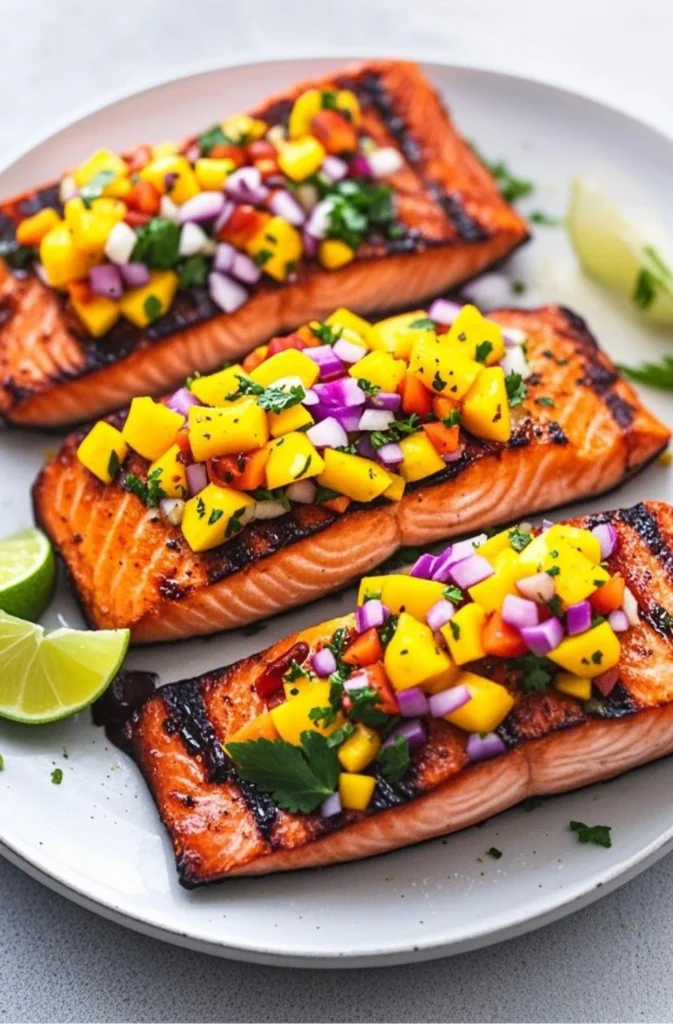
FAQ About Grilled Salmon with Mango Salsa
Can I make salmon with mango salsa ahead of time?
You can prepare both components ahead with slight modifications. For the salmon, complete the marinade process but delay cooking until serving time. Mango salsa can be prepared up to four hours before serving—dice all ingredients and combine everything except lime juice, salt, and avocado. Add these final elements just before serving. For meal prep, store cooked salmon and salsa separately, consuming within two days for optimal freshness.
What’s the best type of salmon to use for grilled salmon with mango salsa?
Wild-caught Alaskan salmon varieties (particularly sockeye, coho, or king) offer superior flavor and nutritional benefits for this salmon with mango salsa recipe. Their firmer texture holds up exceptionally well to grilling. However, sustainably farmed Atlantic salmon provides a more budget-friendly alternative while still delivering excellent results. Look for thick fillets (1-1.5 inches) with consistent color for even cooking.
Can I bake the salmon instead of grilling for this salmon with mango salsa recipe?
Absolutely! Preheat your oven to 425°F and line a baking sheet with parchment paper. Place the marinated salmon skin-side down and bake for 12-15 minutes until the internal temperature reaches 145°F. While you’ll sacrifice some smoky flavor and grill marks, the mango salsa will still complement the baked salmon beautifully. For color development, consider finishing under the broiler for 1-2 minutes.
Is salmon with mango salsa keto-friendly?
Traditional salmon with mango salsa contains approximately 15-18 grams of carbohydrates per serving, primarily from the mango. For a keto-friendly version, reduce the mango to a small amount (2-3 tablespoons per serving) and increase avocado proportion. Alternatively, substitute diced cucumber or bell pepper for mango while maintaining lime, cilantro, and jalapeño for flavor complexity. The salmon portion remains perfectly keto-compatible.
How can I tell when my grilled salmon with mango salsa is perfectly cooked?
Perfectly cooked salmon with mango salsa displays these characteristics: the flesh changes from translucent to opaque pink; it flakes easily when gently pressed with a fork; and it reaches an internal temperature of 145°F when measured with an instant-read thermometer inserted into the thickest portion. For optimal texture, look for slight translucency at the center—carryover cooking will complete the process during resting.
What sides pair well with salmon with mango salsa?
The tropical profile of salmon with mango salsa harmonizes beautifully with these sides: coconut rice or cilantro-lime rice; grilled asparagus, zucchini, or other seasonal vegetables; black bean and corn salad; avocado and citrus salad; or sweet potato wedges with lime-infused sour cream. For a complete meal incorporating multiple food groups, consider serving with quinoa tossed with scallions and lime juice alongside roasted vegetables.

